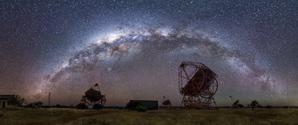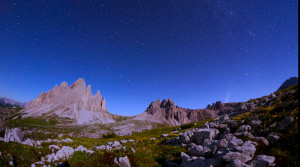Glossarbegriffe: Himmel
Description: Der Himmel ist das, was wir sehen, wenn wir uns im Freien befinden und unser Blick ungehindert nach oben gerichtet ist - oder zumindest höher als der Horizont, der die Grenze dessen markiert, was wir von der Erde und den Strukturen auf ihrer Oberfläche sehen können. Bei klarem Nachthimmel können wir ferne Planeten, Sterne und sogar einige Galaxien sehen (die Andromeda-Galaxie auf der Nordhalbkugel und die Magellanschen Wolken auf der Südhalbkugel). Das Funkeln der Sterne ist der Beweis dafür, dass wir immer noch durch die Gase der Erdatmosphäre hindurchblicken. Tagsüber lässt das von den Luftmolekülen gestreute Sonnenlicht den Himmel blau leuchten und versperrt uns den Blick in den Kosmos. Wolken oder Nebel, die den Himmel bedecken, verhindern ebenfalls, dass wir astronomische Objekte beobachten können.
Zugehörige Glossarbegriffe:
See this term in other languages
Term and definition status: The original definition of this term in English have been approved by a research astronomer and a teacher The translation of this term and its definition is still awaiting approval
The OAE Multilingual Glossary is a project of the IAU Office of Astronomy for Education (OAE) in collaboration with the IAU Office of Astronomy Outreach (OAO). The terms and definitions were chosen, written and reviewed by a collective effort from the OAE, the OAE Centers and Nodes, the OAE National Astronomy Education Coordinators (NAECs) and other volunteers. You can find a full list of credits here. All glossary terms and their definitions are released under a Creative Commons CC BY-4.0 license and should be credited to "IAU OAE".
If you notice a factual or translation error in this glossary term or definition then please get in touch.
Zugehörige Medien
Milky Way Over Quiver Tree
Bildnachweis: Jianfeng Dai/IAU OAE (CC BY 4.0)
License: CC-BY-4.0 Creative Commons Namensnennung 4.0 International (CC BY 4.0) icons
Milky Way Over H.E.S.S Observatory
Bildnachweis: Jianfeng Dai/IAU OAE (CC BY 4.0)
License: CC-BY-4.0 Creative Commons Namensnennung 4.0 International (CC BY 4.0) icons
Big Dipper and Comet Neowise C2020 F3
Bildnachweis: Giorgia Hofer/IAU OAE (CC BY 4.0)
License: CC-BY-4.0 Creative Commons Namensnennung 4.0 International (CC BY 4.0) icons
Southern Sky Over La Silla
Bildnachweis: José Rodrigues/IAU OAE (CC BY 4.0)
License: CC-BY-4.0 Creative Commons Namensnennung 4.0 International (CC BY 4.0) icons












